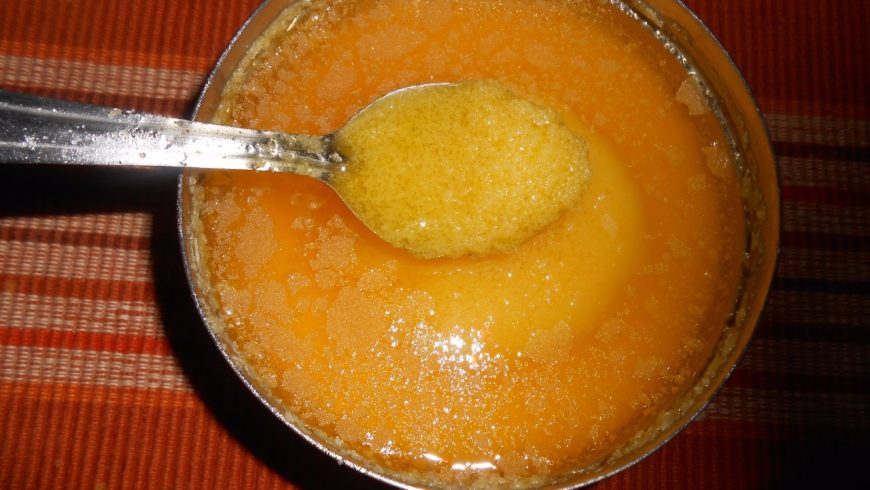While my children were in nursery classes, their staple food (breakfast) was ghee with jaha rice and boiled egg. The aroma and the taste lingered to them so much that even now they will happily gulp down on it before going to office. No doubt it is an excellent menu, but some news on bad effects of ghee on weight gain, cholesterol level etc., deterred me to continue for long. But recent news and scientific studies have proven that ghee has rather beneficial effect on our cholesterol level with many other benefits. Ghee is now back on our plate to satiate our palate.
I now use ghee as my primary cooking fat. I made the switch primarily due to its flavour, but then noticed a welcomed and unexpected shift in a few of my lingering hormonal symptoms. I believe I can credit my increased ghee intake with improving the hormonal imbalance that reared its head. So, reap the benefits of consuming ghee daily. If you already use it, here are reasons to use more of it and if you are new to it, be prepared to rock your culinary world!
We should not forget that Ghee is 100% butterfat, golden, flavourful, nutrient-rich butterfat. Butter contains primarily butterfat, but also milk proteins and water. To make ghee, butter or malai is simmered to separate the oil from the other components, which are strained off. Ghee traces its roots to the ancient tradition of Ayurveda, where it was considered a sacred, medicinal, cleansing, and nourishing food.
Ghee is lactose-free. The ability to digest lactose – a sugar found in milk – varies depending on the quality of the dairy product, our digestive health, and even ethnicity. Nearly 25% of Caucasians and up to 97% of the Native Americans are lactose intolerant, meaning they lack the enzymes required to breakdown lactose. Traditional cultures knew how to improve the digestibility of dairy products. Raw milk, for example, contains enzymes that break down the lactose. Fermenting dairy into yogurt breaks down much of the lactose, and the process of creating ghee removes the lactose and leaves behind a pure butter oil.
Ghee is also casein-free. Casein, the protein component of milk, is blamed for milk allergies (an allergic reaction occurs to the protein in a food). When gut flora is compromised, casein consumption can actually create an opiate effect on the brain because it is not being properly digested. While making ghee, the milk solids containing lactose and casein float to the top, where they are removed. Pure Indian foods offer a lab-tested ghee, certified free of trace remnants of lactose and casein. Culturing – a fermentation process – eats up any traces of these components.
Ghee is a stable fat for cooking. Polyunsaturated oils (plant oils, like sunflower oil and safflower oil) contain many double bonds and are least stable for cooking. Ghee, however, is a primarily saturated fat and is highly heat-stable for sauteing and baking. The smoking point of oils does not indicate the stability of the oil.
Ghee is a saturated fat. That low fat fad is so since 1995 and the saturated fat phobia is so since 2005. Now research has showed that saturated fat consumption does not cause heart disease. For example, there are two monstrous meta-analysis from 2010 and 2014 showing that consumption of saturated fat does not correlate with heart disease.
Ghee boasts bio-available vitamin A. The dairy products of ruminants (cows, sheep, goats) grazing on grass provide an excellent source of fat-soluble vitamins including vitamin A. These vitamins are stored primarily in the fat portion; so, the concentration of vitamins in ghee is higher than in milk. Vitamin A plays an essential role in hormone balance, liver health, fertility, and stamina. Contrary to popular belief, vitamin A cannot be obtained from plant sources such as carrots.
Ghee contains Conjugated Linolenic Acid (CLA). Ghee and butter are the best dietary sources of this fatty acid. As with all nutrients in ghee, concentrations of CLA are drastically higher in ghee from grassfed cows. Numerous studies show that CLA inhibits the growth of breast cancer. Supplementation with CLA has also been shown to cause fat loss and improved body composition in humans. The fat content of ghee plays an essential role in weight loss due to satiation quality. A study done with rats showed how ghee offers health-protective benefits for children.
Ghee is a good source of cholesterol. Further, the cholesterol in ghee is something to revere, not fear. Science tells us that cholesterol does not cause atherosclerosis. As a healing agent in the body, levels of cholesterol rise during periods of stress or when inflammation is present. Providing cholesterol through good quality fats, such as grassfed ghee, allows the body to help address the inflammation.
Interestingly, low blood cholesterol levels are associated with the following:
- A higher risk of mortality
- A higher risk of depression
- A higher risk of committing violent crime and suicide.
- A higher risk of dementia and Alzheimer’s disease.
Grass-fed ghee contains the highly elusive nutrient, vitamin K2. Vitamin K2 is the shuttle that transports calcium into our bones. We can eat as much calcium as we want but it won’t strengthen our bones unless it is accompanied by vitamin K2. As a fat-soluble vitamin, it requires the fatty acids in ghee for absorption.
Ghee contains a significant level of butyric acid, an anti-carcinogenic short-chain fatty acid. Butyric acid has been shown to inhibit the growth of mammary tumours. Butyric acid is also a biological response modifier, a substance that arouses the body’s response to infection. Studies show that it boasts numerous healing and soothing properties on the intestinal tract. Some strains of beneficial gut flora produce butyric acid, and research shows that the butyric acid produced may be a potential treatment for Irritable Bowel Disease.
Ghee has incredible flavour. Ghee is an ancient Ayurvedic skincare secret. It makes an extraordinary body moisturizer – just a dab goes a long way. One can massage ghee directly onto the skin, but not recommended as a facial moisturizer if for oily skin.
Lab studies have shown ghee to reduce cholesterol both in the serum and the intestine. Ghee is also good for nerves and the brain. According to Ayurveda, ghee promotes learning and increases memory retention. Beneficial effect of Brahmi cooked in ghee is well known for enhancing memory. It helps control eye pressure and is beneficial to glaucoma patients. It is rich with antioxidants and acts as an aid in the absorption of vitamins and minerals from other foods, serving to strengthen the immune system. It is good for treatment of burns. It is safer than butter. Now you understand how the Punjabis have tonnes of ghee and are still fitter. It has been used in Indian medicinal practice to help with ulcers, constipation, and the promotion of healthy eyes and skin. During my stay at Hisar (Haryana), I happened to see a recently delivered woman drinking a full glass of ghee to my utter surprise!
For Indians, ghee is a religious matter rather than a food item. Ghee has dominated most Indian kitchens for centuries. Use of ghee in sweets is viewed by customers as the symbol of their quality and richness. But the metabolic epidemic comprising of diabetes, heart disease, obesity and hypertension (metabolic syndrome X) which have emerged in the recent decades in India has put a question mark on this Indian favourite cooking medium.
One tablespoon (15g) of ghee has approximately 135 calories, all of which come from fat. That small amount of ghee has 15 grams of total fat and 9 grams of saturated fat, or 45% of the recommended daily value. A tablespoon of ghee also has 45 milligrams of cholesterol, or 15% of the daily value. Ghee is free of sodium, carbohydrates, fibre, sugar and protein.
It also boosts fertility. An optimal fertility diet should contain good quality protein sources and good fats. Pure ghee is the best form of fat. It increases quality and quantity of semen.
Healthy people should have 3 teaspoons (15g/tablespoon) of desi ghee per day to get all benefits. Preferably one teaspoon of pure ghee, three times a day is beneficial. We can add ghee to rotis, parathas, dal, curry etc. Now ghee is back on my dining table, thanks to our college firm for the milk, Farmly fresh, a privately owned milk parlour by our own vet Dr. Chiranjeevi Acharya, which I use for making ghee! So, why worry?

Chandana Choudhury Barua
Professor, Department of Pharmacology,
College of Veterinary Science, Khanapara




